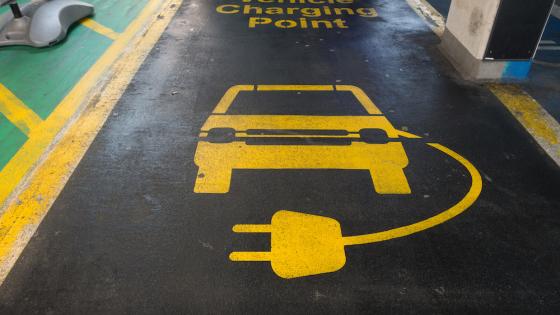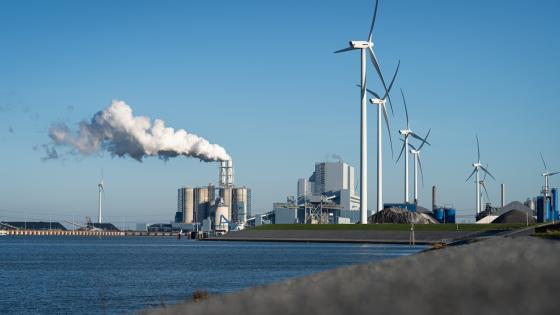Although much of the modern world is powered by fossil fuels, that was not an inevitable outcome of technology and costs. The first electricity generator in the UK in 1868 was hydro-driven, the first commercial photovoltaic solar panel – building on Edmond Becquerel’s 1839 creation of the first photovoltaic cell – was developed by Charles Fritts in 1881, the first wind turbine to generate electricity was built by James Blyth in 1887, and by the 1930s wind-generated electricity was relatively common on US farms. Moreover, electric cars date back to the 1880s after Thomas Parker built a vehicle with a high-capacity rechargeable battery. Thus, an all-electric-powered society is just going back to a future where we might have been 125 years ago.
Zero greenhouse gas electricity generation?
The rapidly falling costs of renewable energy sources like solar cells and onshore wind turbines combined with improved storage methods should substantially reduce oil and gas use in electricity production. Offshore wind turbines have also fallen greatly in cost and increased in efficiency over the past two decades so that for the UK they offer a low-cost alternative with the incidental benefit of creating marine reserves and fish sanctuaries. Wind turbines are cheaper than natural gas combined-cycle turbines even before adding the costs of carbon capture and storage.
Solar photovoltaics come next (for the UK) if carbon capture and storage is enforced, though both wind and sun sources require large backup electricity storage systems for, for example, windless nights, which we’ll discuss below. Renewable energy’s share of overall UK electricity generation reached a peak of 60.5% at one stage in April 2020, according to National Grid data.
Coal use has fallen to near zero in the UK since the 2008 Climate Change Act, without obvious aggregate costs (Hendry 2020). However, natural gas usage has increased 3.5-fold since the mid-1980s and still contributes about 140 megatons (Mt) p.a. to CO2 emissions despite producing less than half those of coal per Btu.
In 2019, the UK government amended the original Climate Change Act target to zero net emissions by 2050. All sources of greenhouse gas emissions must go to a level such that carbon capture and storage, possibly combined with atmospheric CO2 extraction methods, must remove the rest.
Facing an irreducible non-zero minimum demand for oil and gas (e.g. for chemicals), to achieve zero net emissions before 2050 requires major technological change that almost certainly involves developing current research on avenues to remove (Wemyss 2014) or reuse existing CO2 as a fuel (Stanford University 2019). ‘Net zero’ is an excellent target but incredibly difficult to achieve and as yet, there is no sensible UK strategy to do so – so we now suggest some speculative routes.
To meet the net-zero target, natural gas–use must be reduced to near zero, like coal. Natural gas is mainly used for electricity production and household indoor- and water heating. The former could be handled in part by increased renewable sources. Household natural-gas (and some oil) usage could be reduced by increased taxes encouraging the adoption of solar panels and, for example, air heat pumps.1
More radically, the UK could switch back from a national gas distribution system using natural gas to one based on hydrogen, possibly made by electrolysis when there is spare renewable electricity. The UK had a hydrogen-based gas distribution system prior to 1969, but the switch to natural gas required all household equipment to be converted from ones that burned coal gas (which is composed of about 50% hydrogen) to those that burned natural gas (which is mainly methane).
With ever-improving technologies and cost reductions in renewable electricity generation, a near-zero target for natural gas over the next 30 years should be possible without reducing GDP growth – perhaps even increasing growth with new opportunities.
However, as no future technology is certain, more research should be devoted to developing safe small modular nuclear reactors (World Nuclear Association 2020) based on the well-developed nuclear-powered engines in submarines. Variants of small modular nuclear reactors such as molten-salt waste-burners https://www.seaborg.co/ may be able to use non-fissionable thorium or the ‘spent’ uranium fuel rods from older reactors, helping to reduce the serious problem of transuranic-waste disposal. Part of those disposal-cost savings should be put towards the building of small modular nuclear reactors, perhaps supplemented by reallocating the £40 billion saved by abandoning the Hinkley Point C nuclear power station.
Even over our horizon of 30 years, nuclear fusion seems unlikely to be a key energy contributor despite many developments, such as increasing output efficiency (Bennett 2017) and reducing internal damage to tokamak materials from helium (Galeon 2017), which might then be collected, offsetting a potential shortage.
Zero greenhouse gas transportation?
Reducing oil use in transport to zero will take longer following current strategies, even with more efficient engines (diesel being phased out completely given its toxic pollutants), and much higher taxes on gasoline. Without a major improvement in lithium-ion-battery-powered electric vehicles, their relatively short journey capacity despite taking a non-negligible time to recharge discourages the replacement of internal combustion engines.
However, recent advances have been made in understanding the properties of graphene, with potentially large falls in its cost of production (see ‘graphene in a flash’ from plastic waste, Williams 2020). Graphene nanotubes can act as electrode super-capacitors, and there may be something like a variant of Moore’s law (which states that processing power of computers doubles every two years) that could lead to cost reductions stemming from a large increase in their production.
Imagine sandwiching an array of graphene nanotubes (Sammed et al. 2020) between two Faraday cages in a prefabricated modular unit fitted to a vehicle’s roof (perhaps even retrofitted on existing car roofs) to power an electric motor, so the vehicle becomes the battery. Graphene nanotubes seem capable of rapid charging and should be able to sustain viable distances on a single charge.
Moreover, if such electric vehicles are successful, mandating them to be plugged in when not in use will translate into a vast electric storage system for no additional investment, with cars acting as the National Grid’s storage. Thus, renewable sources of electricity could be widely adopted without worrying about the security of supply.
There are undoubtedly many technical issues that need to be solved before such a system could work in practice, but there is much going on – such as developing 2-dimensional tri-layers of graphene (Graphene-info 2020) as an insulator, superconductor, and magnet.
Several steps are possible for the UK to rapidly advance research on GNTs: (1) offer EPSRC significant additional funding for a general call to research the topic; (2) approach Manchester University directly as a world leader in graphene research with two Nobel Laureates; (3) offer a world-wide prize of £10m+ for the first car to successfully meet appropriate criteria, with the patent to the UK Government; (4) contact major UK motor manufacturers of electric vehicles for interest and support; (5) make the call more general as other light materials could play equivalent roles as sources of electricity. Other steps include research on smart meters to be able to register both payments for taking power from fast chargers, and recording kwhs withdrawn from the grid and needing replaced for free; and contemplating a grid of fast chargers.
The potential benefits of such a power source would be huge as a ‘sensitive intervention point’ (Farmer et al. 2019 cite the UK’s Climate Change Act of 2008 as a timely example with a large effect).
By not demonising road transport for its CO2 footprint and dangerous pollution, cars with internal combustion engines could be replaced at a rate matching obsolescence and the increased need for storage from the extension of renewables. The basics of electric engines are established, so employment can be maintained in vehicle manufacture and many of its ancillary industries rebased on graphene nanotubes. Two side benefits are a major reduction in both mining for lithium and later disposal or recycling of the resulting toxic battery waste; and eliminating the need for expensive catalytic converters, markedly cutting production costs, eliminating a target for theft (which then exacerbates air pollution), and reducing palladium mining.
Indirect consequences could solve the UK rail system’s problem of a lack of electrification across much of the network, by replacing diesel-electric trains with graphene-nanotube-supplied electric ones, although some progress is also being made with hydrogen-driven trains in Germany and the UK (University of Birmingham, n.d.). As graphene nanotubes are so light, they could stimulate a large increase in economical electric-powered aircraft (Travierso 2013).
Zero greenhouse gas emissions overall?
Agriculture, construction, chemical industry, and waste management look more problematic, although there have been some improvements in efficiency. Inner-city underground (Frangoul 2018) and vertical farms (Despommier 2009) economise on water, fertiliser, and energy – partly from transport reductions – and are increasingly viable given the falls in costs of LED lighting.
There is research on altering farm-mammal diets to reduce methane emissions, including adding dietary fumaric acid (from plants like lichen and Iceland moss) whereby lambs showed a reduction by up to 70% (UPI 2008). Changes to human diets also need encouraging (Wenham 2020).
Prefabrication of highly insulated dwellings must be a priority, as well as using less greenhouse-gas-intensive building materials. Recycling more, using more waste for fuel, and landfilling less to reduce methane leakage are all essential.
Zero imported CO2?
The UK’s total ‘consumption-induced CO2' (University of Leeds n.d.) equivalent emissions are higher than the domestic level through CO2 emissions embodied in net imports (Peters et al. 2012), although the large reductions achieved to date have a major domestic component and ‘consumption-induced’ CO2 will fall as the CO2 intensity of imports falls with reductions in exporting countries.
Targeting consumption rather than production emissions has the unwanted consequence of reducing incentives for emitting industries or exporting countries to improve their performance, as these would not be counted against them (e.g. if nationally decided contributions used a consumption basis).
Border carbon taxes have a role to play in improving both exporters’ and importers’ performance. Similarly, allocating emissions from transport and packaging to, say, the food sector would again alleviate those intermediate sectors of the responsibility to invest in reducing what are in fact their emissions by attributing them to retail outlets or consumers. Conversely, the purchasing clout of large retail chains can pressure suppliers to improve, as, for example, Walmart is doing (Walmart 2019).
The aggregate UK data provide little evidence of there being high costs to the reductions in CO2 emissions, which have dropped by 186Mt from 554Mt to 368Mt (34%) so far this century, during which period real GDP per capita has risen by more than 25% despite the ‘Great Recession’ (not including the pandemic-induced falls).
Historically, those in an industry that was being replaced (usually by machines) lost out and bore what should be the social costs of change, from cottage spinners, weavers, and artisans in the late 18th to early 19th centuries (inducing ‘Luddites’), to recent times (from a million coal miners in 1900 to almost none today). Greater attention needs to be paid to the local costs of lost jobs as new technologies are implemented: mitigating the inequality effects of policies introduced to avoid climate change must matter.
Given the important role of the capital stock in production, ‘stranded assets‘ (Pfeiffer et al. 2016) in carbon-producing industries are potentially problematic as future legislation imposes ever-lower CO2 emissions targets to achieve zero net emissions, but so are jobs in those industries.
An excellent model that offers hope for major reductions in energy use is the dramatic increases – approximately 100,000-fold – in lumen-hours per capita consumed since 1300, at 1/20,000th the price per lumen-hour (Fouquet 2006).
Conclusions
While speculative, in the complete absence of any plan by the UK government on how to reach net-zero greenhouse gas emissions, these proposals suggest possible strategies for moving towards a low-carbon future for the UK.
Although described in the context of the UK’s policy and performance, most of the proposals are generic. Let’s not waste the recovery from the pandemic (Harrabin 2020) by ignoring the chance to tackle burgeoning climate issues.
References
Bennett, J (2017), “MIT achieves breakthrough in nuclear fusion”, Popular Mechanics, 28 August.
Despommier, D (2009), “Growing skyscrapers: The rise of vertical farms”, Scientific American.
Farmer, J D, C Hepburn, M C Ives, T Hale, T Wetzer, P Mealy, R Rafaty, S Srivastav and R Way (2019), “Sensitive intervention points in the post-carbon transition”, Science 364(6436): 132–4.
Fouquet, R (2006), “Seven centuries of energy services: The price and use of light in the United Kingdom (1300-2000)”, Energy Journal 27(1): 139–77.
Frangoul, A (2018), “In London, there’s an underground farm growing salad without soil”, CNBC.com, 30 August.
Galeon, D (2017), “A helium-resistant material could usher in the age of nuclear fusion”, Futurism.com, 14 November.
Graphene-info (2020), “Graphene acts as superconductor, insulator and ferromagnet in a single device”, 5 March.
Harrabin, R (2020), “Make Covid-19 recovery green, say business leaders”, BBC, 1 June.
Hendry, D F (2020), “First in, first out: Econometric modelling of UK annual CO2 emissions, 1860–2017”, Economics Papers 2020-W02, Economics Group, Nuffield College, University of Oxford.
Peters, G P, S J Davis and R Andrew (2012), “A synthesis of carbon in international trade”, Biogeosciences 9(8): 3247–3276.
Pfeiffer, Alexander, Richard Millar, Cameron Hepburn and Eric Beinhocker (2016), “The ‘2°C capital stock’ for electricity generation: Committed cumulative carbon emissions from the electricity generation sector and the transition to a green economy”, Applied Energy 179: 1395–408.
Sammed, K A, L Pan, M Asif, M Usman, T Cong, F Amjad and M Asif Imran (2020), “Reduced holey graphene oxide film and carbon nanotubes sandwich structure as a binder-free electrode material for supercapcitor”, Scientific Reports 10: 2315.
Stanford University (2019), “New route to carbon-neutral fuels from carbon dioxide”, ScienceDaily, 16 September 2019.
Travierso, M (2013), “10 electric planes to watch”, IEEE Spectrum, 2 August.
University of Birmingham (n.d.), “Hydrogen-powered train”.
University of Leeds (n.d.), “Consumption emissions over time”, Exploring the UK’s Carbon Footprint website.
UPI (2008), “Scientists look to cut cow flatulence”, UPI.com, 20 March.
Walmart (2019), “Walmart on track to reduce 1 billion metric tons of emissions from global supply chains by 2030”, 8 May.
Wemyss, E (2014), “Carbon injection initiative supported by new research“, Phys.org, 16 September.
Whenham, A (2020), “Nuffield College’s Decreasing Food Emissions”, Climate Econometrics, 18 March
Williams, M (2020), “Lab turns trash into valuable graphene in a flash”, Phys.org, 27 January.
World Nuclear Association (2020), “Small nuclear power reactors”, May.
Endnotes
1 Tax increases, such as to VAT on household fuel, are to change behaviour, not to raise revenue, so should be redistributed to protect families facing fuel poverty.



